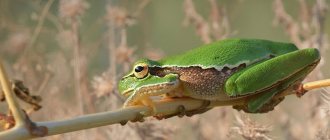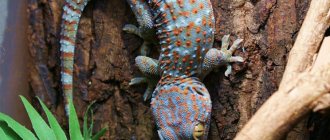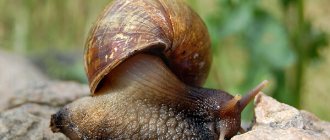A spider as a pet is much less common than the usual cats or dogs. At home, the tarantula spider is usually found only among spider breeders or ardent lovers of exotics.
When planning to get a spider, you need to carefully study the natural conditions familiar to a particular species in order to subsequently try to create a comfortable microclimate for the pet.
In addition, it is important to choose a terrarium (spider cage) of a suitable size and organize proper nutrition.
Rules for keeping tarantula spiders at home
As mentioned above, spiders are found in regions with hot climates. This must be taken into account when keeping individuals at home. Among the most important points to pay attention to when placing an animal are the following:
- The pet must move freely around its home, so it needs to choose a spacious container.
- Tarantula spiders love warmth, but bright sunlight harms them. Place your pet in a warm and dark place in the house, and do not forget about the humidity of the room.
- It is necessary to monitor the behavior of individuals; outbreaks of aggression between young and adult pets often occur. Throughout life, there are several key moments, which include periods of reproduction and the emergence of the younger generation. To avoid cannibalism, adult pets should be transplanted from young animals in a timely manner.
- The animal often sheds and pollutes its home; it is necessary to periodically clean the terrarium, as well as change the soil to maintain optimal living conditions.
What should a spider's home be like?
Animals may experience stress when moving from their natural habitat, so choosing a new home is key when it comes to pet placement. When choosing a habitat, pay attention to the following parameters:
- A terrarium or aquarium is perfect for creating an artificial habitat, and there should be enough space for your pet. It is necessary to take into account the size of the individual and take a terrarium with a wall that is twice the length of the animal’s body.
- For underground species, soil at the bottom of the container is suitable; its thickness should be at least 5 cm, and soft and hard layers of soil can be combined. For those individuals that lead a terrestrial lifestyle, you will have to additionally install a snag or a small log in the aquarium. Spiders will crawl along this snag and also weave webs on it.
- An equally important issue is maintaining climatic conditions. The pet's habitat should be warm, the temperature should not be lower than 25 °C. But at the same time, it is better to hide the aquarium from direct exposure to sunlight.
Nutrition
The tarantula spider at home feeds on beetles, cockroaches, earthworms and beetle larvae. Feeding insects are specially grown to feed arthropods. Young animals are given zofobas or darkling beetle larvae; They are popularly called mealworms.
The length of the larva should correspond to 1/3 of the size of the abdomen. If after feeding it does not increase in size, then the individuals are given more food. A sign that the tarantula has eaten is an enlarged abdomen. After molting, adult spiders are given the same soft food as young ones.
At home, the tarantula is fed with darkling beetle, zofobas, Madagascar, Argentine, and Turkmen cockroaches. He can catch a cricket, a grasshopper, a locust, a small lizard. Animals love to hunt them. Insects are placed in a terrarium alive. The remaining feed is removed so that it does not rot.
Care for tarantula spiders is minimal. It is important for them to provide warmth, moist air and soil, and good ventilation. Feeding is carried out once a week. The young are given food every 3 days.
It is recommended to clean the bedding from feces and food residues. To do this, the tarantula is moved to another container. The soil is heated in a frying pan. You must handle the animal with great care.
Cleaning and cleaning, hygiene
Correct and high-quality soil poured into the terrarium is very important . Good soil helps maintain optimal moisture levels. You can choose the soil yourself quite easily. Such a substrate must have good air permeability. Among other things, the soil must be as clean as possible to prevent the development of putrefactive microflora and mold. The optimal substrate is one with sufficient moisture content, but not too fine.
To make the substrate sufficiently moist, it is necessary to regularly wet the soil with clean water at room temperature. Excessive waterlogging and insufficient soil moisture inside the terrarium are unacceptable, and often become the main cause of death or death of a pet. Hygienic cleaning of the walls and bottom of the terrarium should be carried out as it gets dirty. It is also possible to partially replace the substrate.
This is interesting! Experienced owners of tarantula spiders recommend adding coconut substrate to the bottom of the terrarium, which has all the characteristics necessary for keeping arthropods at home.
Priming
If we figured out the terrarium and the spider, now we need to know what to put in the spider’s terrarium. The soil is very important, since it serves as the basis for the home, it is important for maintaining humidity, and besides, it is through the soil that spiders will drink - they will most likely either mercilessly bury the drinking bowl, or weave it, or even shit in it. Selecting soil is quite easy. It should allow air to pass through well, not mold, maintain the required level of humidity and not be too small. Therefore, ordinary soil is not suitable for flowers; moreover, it may contain insecticides. Decorative sand or regular sand are also not suitable, since the sand contains very small particles that the spider can inhale and die. Coconut substrate is best suited for these purposes. Now it has gained great popularity; it can be easily obtained in almost any store for a relatively low price. It is also not recommended to use vermiculite or perlite, because these substrates contain many small particles; in addition, spiders living on these soils often become more aggressive, apparently experiencing stress.
Reproduction
The sex of a tarantula spider is easy to determine if you follow the recommendations of experts. Young spiders begin to molt after about a month. After molting, the skin is taken and carefully examined. In the posterior region of females there is a depression, and in males there are something like two tubercles. If the individuals are adults, then the sex can be determined by appearance. Males have slightly slimmer legs and are taller, while the body is significantly smaller in size than the female.
After mating, the eggs develop inside the female for 2 months. During this period, she must form a special cocoon. At one time, she can lay up to 500 eggs, while about 50 spiders remain alive. In order for the juveniles to actively develop, the cocoon is moved to a separate terrarium, thereby creating certain temperature conditions.
For the first month, baby spiders do not eat anything, until the first molt. Until this moment, they can be together, after which they are separated one by one. A female tarantula spider molts up to 12 times during her entire life. Males stop moulting immediately after puberty.
Interesting to know ! The tarantula spider is constantly growing and maturing, which is why it needs to shed its “old clothes”. Before molting, individuals turn over on their backs, trying to remove their old skin. At the same time, he completely stops eating. After molting, the spider gets a new color, and the pile is completely renewed.
Danger to humans
Before you get such an undemanding pet at home, you should find out how poisonous it is. It must be remembered that although this type of spider can bite a person, these bites do not pose a danger.
The animal can bite if it feels its life is threatened, but before that it can rise on its hind legs and create menacing hissing sounds. The tarantula spider bites with chelicerae, at the end of which there are fangs, the length of which is about 2 cm. During the bite, it injects poison.
The bite site becomes inflamed, followed by swelling and swelling. All this is accompanied by pain. After about a week, the negative consequences of the bite disappear. This is especially true for people prone to allergies, as well as those with weakened immune systems. After a bite, such people experience a deterioration in their general health and severe weakness, with nausea, diarrhea, dizziness and headache.
Spiders cannot be trained in any way, so a person must study their behavior patterns. If the spider has poisonous hair, then it is better to handle it while wearing gloves, otherwise it may irritate the skin.
It is important to know! There is a category of people suffering from arachnophobia - fear of spiders. If such a person accidentally and unexpectedly encounters a tarantula spider, he may die of fear. In this regard, it is necessary to ensure that the animal is not able to leave the terrarium and does not start traveling around a person’s home, or even worse, among its neighbors.
Advantages and disadvantages of keeping a spider
Many people keep spiders for the purpose of shocking. Like, look at the scarecrow that lives with me, is it impressive? But such people are in the minority. There are, of course, individuals who are obsessed with spiders, who admire their habits and opportunistic features. But, basically, spiders are owned by those who consider them to be very beautiful pets.
And from this judgment follows the main, in my opinion, advantage of spiders - their appearance. Now you can buy spiders of a wide variety of colors, there are pink, red, pitch black and even bright blue. These are incredibly beautiful animals that are a pleasure to look at.
This type of spider has very interesting, curled hairs.
The main reason why I got myself a spider is its unpretentiousness. Such a pet can be left for a week or more with a clear conscience. If you need to go somewhere, then rest assured that the spider will wait for you and will not die of hunger, since it can go without food for a very long time.
This is an ideal option if you have a small living space. It does not take up much space and does not create noise. If you remove leftover food, there will be no unpleasant smell either. He doesn't shed his fur in the usual sense and you don't need to walk with him - a miracle, not a pet.
One of the main disadvantages is that spiders are quite secretive people. Most likely, your pet will hide in a shelter most of the time.
You can't pet a spider in the usual sense of the word. Even picking him up is not recommended, as this is very stressful for the animal.
A particular disadvantage is the presence of food animals in your home. For example, if you decide to keep a colony of cockroaches yourself, then you won’t leave them for a month.
Well, despite their terrifying appearance, spiders are quite fragile. Even a fall from several tens of centimeters threatens the spider with death. The animals are quite nervous. Factors such as transportation, changing the terrarium, and an abundance of insects can cause stress. Spider stress is bad. The pet may comb its hairs, refuse to feed and, in especially severe cases, even die.
It doesn’t bark, doesn’t bite, doesn’t rush at passers-by... Just kidding, of course, a spider can bite, it has everything for that. But such cases are extremely rare. Of course, the venom of all tarantulas is toxic to one degree or another. But an adult should not have any serious problems.
What age should I take a spider?
Finally, you have decided on the type and begin to look for where to buy the pet you need. Almost immediately you come across a ton of advertisements, but for some reason they have a big difference in price. The fact is that the cost of a spider depends on age and gender. And then you say that it’s easier to buy a small spider, watch it grow, and the price is quite satisfactory. That’s how it is, but it’s better not to do this without experience in content. Young spiders are tiny and require much more care than adults, and besides, it is much more difficult to find food for small spiders than for an adult. As for gender, it is worth noting that male tarantulas live much shorter than females, and they are also much smaller in size, and therefore they are rarely of collection value. There are species in which the males are much more beautiful and brighter than the females, but this is a very rare case. Therefore, if you want the spider to live with you as long as possible, then you should get a female.
Kit for tarantula of the genus Caribena (Avicularia) “Standard”
Shedding
Regular replacement of the exoskeleton, which is not capable of stretching, is necessary for the growth of the tarantula and is considered a natural physiological process. The shedding period is called molting. In adults, this happens annually, and at a young age, spiders molt several times a month. The approach of molting is indicated by darkening of the color and partial loss of hairs. Often animals refuse food and lie down on their backs. It happens that when the old integument is shed, the hind legs come off, which later grow back. Important! Tarantulas do not require human assistance when getting rid of their exoskeleton and can even cause harm.
Diseases, treatment and prevention
Diseases affecting tarantulas are currently classified as insufficiently studied, so there is no established practice for their treatment. The most common cause of death for a spider living in captivity is severe dehydration, so the substrate must be constantly and sufficiently well moistened.
The tarantula may also die as a result of injury or severe bruising . To prevent your exotic home from falling from a great height, it is very important to use a cover with small but numerous ventilation holes to cover the terrarium. In order to treat the wound caused by arthropods, regular petroleum jelly is used.
Several types of mites can parasitize spiders, but the greatest danger to exotics is posed by predatory ectoparasites, which infect the lungs of the arthropod and cause a fairly rapid death of such a pet. For preventive purposes, a complete replacement of the substrate in the terrarium should be carried out every six months. Internal parasites, represented by nematodes, cause no less harm to the spider, so it is very important to keep the tarantula’s home clean.
Where to keep
Typically, glass or plastic terrariums with good sealing are used to keep spiders. They can be of horizontal and vertical type: the former are suitable for ground spiders, and for arboreal species a vertical type of housing with effective ventilation is required
Therefore, it is very important to know the type of your pet in order to recreate natural conditions for it as accurately as possible.
Most species do not require much space, since they spend almost all their time passively, hiding in hollows, burrows and other shelters. However, the length of the home must be at least twice the span of the pet’s legs. In a terrarium that is too large, the pet will experience obvious discomfort and a desire to hide away.
The terrarium should also not be too high, so that if the pet falls from the walls, it will not be damaged. For example, for adult tarantulas, a container with the following parameters is quite sufficient: 30*30*20 cm. For young tarantula spiders (up to several molts old), a plastic container measuring 10*8*6 cm is quite enough. After 7-10 molts, you can buy a home larger size, based on the size of the pet.
Consider the ins and outs of keeping spiders such as the wolf spider, tarantula, black widow and tarantula at home.
How long does a tarantula live in captivity?
The lifespan of different species of tarantulas when kept in captivity varies greatly. For example:
- arboreal species and tarantulas belonging to the genus Pterinochilus - no more than 7-14 years;
- all large terrestrial species - about 20 years.
Males mature earlier than females, at about a year and a half, so most often the average life expectancy of a male tarantula after the last molt does not exceed six months. However, so-called long-lived males who have lived for long periods of time are also known:
- males of Grammostola rosea – one and a half years;
- males Megarobema velvetosoma – nine months;
- males Poecilotheria formosa - about 11 months;
- males of Poecilotheria ornata – a little over a year;
- males Poecilotheria rufilata - approximately one and a half years.
A unique and rare case has been recorded in which a captive male arboreal tarantula Poecilotheria regalis was successfully able to molt a couple of times with a month and a half interval between molts
Defense mechanism
Tarantula spiders have three types of defense mechanisms against external enemies.
- Bites.
- Burning hairs from the abdomen.
- Attack with excrement.
Bites
The bite of a tarantula spider combines the painful sensations of piercing the skin with the action of the poison that spiders use to kill their victims and therefore you need to be doubly careful.
Many people are interested in what happens if a tarantula spider bites them? We answer that the reaction of each organism is individual: from mild itching to headache, fever and severe inflammation. However, no deaths from spider bites have been observed.
But if the tarantula spider is not dangerous to humans, this does not mean that there is no need to be afraid of it at all. Cases of cats dying after spider bites have been recorded.
Burning hairs
The hairs on the bellies of tarantulas can cause an allergic reaction when in contact with the skin of a person or animal. Therefore, spiders use them to protect the most valuable thing – egg laying. Females weave stinging hairs into their web and cocoon.
Excrement
Some types of spiders, when defending, shoot a stream of excrement in the direction of the enemy's eyes, trying to blind the enemy.
Precautionary measures
The most poisonous tarantula on our planet is the incredibly beautiful and bright arboreal metal tarantula (Poecilotheria metallica). This is a very strong and fast, aggressive and completely unpredictable arthropod, the distinctive feature of which is the ability to jump high.
The venom of this species is very toxic, and a bite can cause severe pain, increased heart rate, increased sweating, migraines, muscle cramps or severe weakness in humans. However, as practice shows, a fatal outcome is unlikely. Despite the fact that the woody metal tarantula spider is very rare and is listed in the International Red Book, it is sometimes found in the collections of connoisseurs of exotic arthropods.
Characteristics and description
The tarantula spider is an arthropod from the spider family, distinguished by its large size and ability to survive in extreme natural conditions, as well as in the artificial environment. It is for this reason that keeping tarantulas at home is currently becoming increasingly popular among fans of exotic animals.
It is noted that this species inhabits all continents on the planet. The only exception will be Antarctica, whose weather conditions can withstand only some species of animals. It is quite rare to find a spider in various parts of Europe. But even in desert conditions it can survive and actively reproduces.
On each pair of legs the animal has fibers that resemble fur. Its dimensions vary from 8 to 30 cm in diameter. The bodies of individual individuals can grow up to 15 cm in diameter. The spiders are quite large - some adults can hunt frogs.
A well-fed spider is rarely mobile
The color of the tarantula depends on the species and can be dark brown, blue, purple, or black. Activity and main location also depend on the type of animal. Arboreal individuals prefer to stay most of the time in the crowns or trunks of trees. Burrow or earth spiders make a depression in the ground.
Activity occurs in cases of emergency or at a time when the tarantula is hungry. Even a hungry spider is not characterized by haste and sudden movements, but a well-fed one is practically motionless and may not leave its nest for several months. This feature is most often observed in female tarantulas.
The tarantula does not pose a mortal danger to humans, but its bite cannot be considered non-venomous. Any spider of this species, when bitten, releases poison, which can cause itching, severe pain, swelling and hyperemia of the skin in people prone to allergic reactions. In some cases, a person may experience cramps in the limbs or the whole body.
In this video you will learn more about the tarantula spider:
Features of choosing a pet
In order to choose a healthy spider, you need to use a few simple tricks that will help protect yourself from wasting money:
- the arthropod must be active and playful. In the case when the specimen you have chosen lies alone on the sidelines, is passive and constantly hides in the house, the animal is most likely sick, and you should not buy such a pet for home;
- A healthy spider's abdomen should be even and smooth. If the abdomen is wrinkled or there are other pathologies on it, the spider suffers from dehydration and may soon die;
- open wounds or ulcerative defects on the body of a tarantula are another reason to refuse to purchase such a spider;
- It is best to purchase small spiderlings , since it is almost impossible to determine the age of a tarantula by appearance;
- It is important to pay attention to the hairs that cover the abdomen. If they are not evenly distributed throughout the body or vary in size, the animal has health problems;
- the absence of paws in most cases is not a pathology , since they will instantly grow back after the next molt. This only means that the animal was not transported properly.
Important! When choosing a tarantula, you need to pay attention especially to females, since males do not have longevity and live several times less.
How to make and decorate a terrarium for a red-eared turtle: drawings, description, photo
First of all, you need to choose the right material for making the product. When reading information on various forums and web resources, we can conclude that a glass box will be very expensive, and OSB contains toxic substances; plywood will be the most affordable and safest.
- First you need to determine the dimensions and purchase the required amount of plywood. The larger the dimensions, the better it will be; the animal will feel more comfortable and free, moreover, this directly affects the growth of the pet.
- Now we move on to the stage of selecting tools and materials; we will need: glue, plywood, liquid nails, a drill, and self-tapping screws.
- You need to take one element of plywood, which will make up the bottom part; you need to glue it and screw small pieces of plywood, taking 1 centimeter from the edge. These elements will be a kind of supports, after which you can glue the side wall.
- The sides are reinforced with corners.
- When the side parts are prepared, we can move on to the back part. It is glued with glue and additionally screwed with several screws.
- The lid is screwed on using the same method; it should securely close the structure from above. In our case, the box will open from the side.
- You can move on to the bottom part. You need to take three small pieces of plywood and glue them to the floor, then secure the larger piece of plywood on top.
- In our design there will be two glasses at the front; their movement is ensured by slats. First, the slats are fixed, after which the glass is inserted.
- Ventilation is provided on the side, which will make the pet’s existence more comfortable. First you need to purchase a ventilation mesh and make holes for it.
- At this stage, the body is already ready, then you just need to decorate it, but further work depends on the individual preferences and characteristics of the pet.
READ Do-it-yourself quail barn: how to make it quickly and efficiently This is the easiest option to create; we must not forget about very important elements such as light, heating, feeders, drinking bowls, pools, etc.
Exotic animals are quite suitable for keeping at home. However, for their full existence it is necessary to create suitable conditions. For this purpose, terrariums are equipped.
We will tell you what requirements a terrarium must meet to keep various animals. Let's start with the turtle. At home, you can keep land turtles, as well as freshwater turtles (including red-eared turtles).
The most important mistake is keeping these animals on the floor of an apartment or house. You can organize a ground terrarium; it must have suitable characteristics. However, it is unacceptable to allow a turtle to roam around the apartment; this is harmful for the pet.
There are many species of land turtles. For home keeping, in most cases, medium-sized turtles about 20 cm are chosen. You can make a terrarium for a turtle yourself, what you need for this:
- Purchase and glue glass;
- Organize ventilation;
- Carry out UV lamps;
- Select soil.
For a small turtle of about 12 cm, a terrarium with a minimum size of 60x40x40 cm is required
But it is important to ensure that there is enough space if the turtle grows. If there are several turtles, the dimensions should accordingly be twice as large
The terrarium of land turtles should not be cluttered with various kinds of obstacles that will interfere with movement. The following soil should be placed on the bottom:
- A mixture of sand and clay;
- Hay;
- Wood chips;
- Large pebbles.
Terrarium for a land turtle
Terrariums for turtles should be well ventilated. For this, two holes are made:
- The first is large, located on top of the terrarium;
- The second is small, on the front wall of the terrarium at the base of the soil.
Air temperature is a very important factor that should be properly organized in the terrarium. The turtle terrarium is equipped with a 60 W incandescent lamp, which is installed on top. Bottom heating is not recommended, as it is harmful to the animal’s kidneys. The lamp should heat one corner more strongly, here the turtle will bask and eat food (temperature about 28°C). The house is installed in a cooler corner (about 24°C).
READ Keeping Guinea Pigs in a Terrarium
Aquaterrarium for the red-eared turtle
Is it possible to pick it up?
It is not prohibited to pick up a spider; the main thing is to tame the animal so that it does not cause stress to it. When stressed, a spider may attack you and even bite you. Therefore, tarantulas need to be tamed gradually and immediately after purchase. The animal must understand that you will not harm it; to do this, you must first gently stroke it on the back. Gradually, the pet will reach out to the hand and begin to climb on it. At this time, the main thing is to ensure that your pet does not run away, since in most cases the animal will disappear without a trace.
How much does a tarantula spider cost?
These exotic animals are not that cheap, as some of the species cost a lot of money. You can purchase a tarantula spider in various ways: via the Internet or through an advertisement, or by going to a pet store. Depending on the type, you will have to pay from 100 to 10 thousand rubles. Moreover, females are always more expensive.
When choosing a pet for yourself, you should pay attention to a number of factors, including age. It is better not to buy too large individuals, as they may be old. Secondly, you should pay attention to the shell. If they are damaged or have wrinkles or cracks, it is better not to take such individuals, as they may turn out to be sick. It is not recommended to buy spiders before or immediately after molting, since it is not possible to determine how active the animal is.
Population and species status
Photo: Male tarantula spider
Today, the tarantula spider is considered a fairly common arachnid. They are distributed almost everywhere. The exception is Antarctica, as well as some regions of Europe. There are several species that are not as common as others, but they are not included in the list of flora and fauna listed in the Red Book.
There are no special events or programs related to spider conservation in any country in the world. However, where spiders are quite common, information work is being carried out with the population regarding behavior when encountering a poisonous arthropod, since it can pose a serious danger.
The tarantula spider is quite common in various countries of the world as a pet. Breeders and lovers of exotic animals often choose it. It is not whimsical in terms of living conditions, is not rare or expensive, and does not require any special nutrition. To get such an extraordinary pet, you need to carefully study the conditions of its maintenance and feeding habits.
The tarantula spider has a rather specific, bright appearance and impressive size. It is distributed in almost all corners of the globe. When meeting him, do not forget that the spider is poisonous. Breeders of exotic animals are advised to familiarize themselves with first aid measures for insect bites.
Tags:
- Opisthothelae
- Panarthropoda
- Theraphosoidea
- Big spiders
- Giant spiders
- Bilaterally symmetrical
- Animals of Australia
- Animals of Australia and Oceania
- Animals of Eurasia
- Animals of Spain
- Animals of Italy
- Animals of the forest
- Animals starting with the letter P
- Animals of New Zealand
- Semi-desert animals
- Desert Animals
- Animals of deserts and semi-deserts
- Animals of North America
- Animals of the Subtropical Zone of the Southern Hemisphere
- Animals of the Subequatorial Belt of the Southern Hemisphere
- Rainforest Animals
- Rainforest Animals
- Animals of the Tropical Zone of the Northern Hemisphere
- Animals of the Tropical Zone of the Southern Hemisphere
- Animals of the Temperate Zone of the Southern Hemisphere
- Animals of South America
- Shedding
- Mygalomorph spiders
- Dangerous spiders
- Spiders
- Tarantula spiders
- Protostomes
- The largest spiders in the world
- The most dangerous spiders
- The most terrible spiders
- Cheliceraceae
- Arthropods
- Eukaryotes
- Eumetazoans
- Poisonous spiders
Reviews from tarantula owners
The tarantula spider cannot be raised, trained or tamed in the sense of such words that are familiar to owners of exotics . Even a very calm tarantula may well bite its owner if it suddenly senses danger.
This is interesting! Experienced spider keepers recommend performing all manipulations related to maintaining the terrarium using special, fairly long tweezers.
As the owners note, tarantulas, which were surrounded by attention in childhood and were often picked up, are most relaxed about their surroundings and their owner.
LIZARD: DESCRIPTION, PHOTO, REPRODUCTION, SPECIES, FOOD, LIFESTYLE
CHAMELEON: LIFESTYLE, HABITAT, PHOTO, SPECIES, REPRODUCTION, HUNTING
IGUANA: CARE AND MAINTENANCE AT HOME, PHOTO, DESCRIPTION
Breeding
Now let's talk about how to properly breed a tarantula spider at home. In order to properly maintain such an unusual animal from the point of view of the average person, you need to know several rules.
Terrarium
A terrarium for a tarantula spider needs to be selected and equipped depending on its belonging to one category or another. So, for example, for arboreal representatives, the height of the walls of the structure should be no lower than 35-50 centimeters. It’s a good idea for such a home to have an interesting tree branch that your animal could climb on as in natural conditions.
Ground spiders are given a terrarium that is elongated in length so that the pet can have somewhere to run and frolic.
For burrowing spiders, it is desirable to have an improvised burrow, similar to one made in nature. These could be objects such as:
- coconut shell;
- shell from a large mollusk;
- a piece of bamboo trunk;
- clay cup with a broken side.
Regardless of the type of spider, the bottom of the terrarium should be covered with loose substrate. Coconut shavings are best suited for this, although clean, dry soil can also be used.
Climatic conditions
For residents of warm tarantula countries, temperature means a lot. When kept at home, you need to maintain it at a level of 25 degrees Celsius. This can be achieved by using special heat lamps or heating mats on the bottom of the terrarium.
Humidity also plays a big role for the inhabitants of the subtropics. It should be at a level of 80-90 percent. To do this, spray the substrate 2-3 times a day or place a bowl of water, which humidifies the air as it evaporates.
Feeding
The domestic tarantula spider is unpretentious in food, the main thing is that it is of animal origin and larger in size than your pet’s body.
The choice of what to feed the tarantula spider at home is varied, it can be:
- locusts and grasshoppers;
- large insects;
- little mice;
- baby frogs;
- worms;
- bloodworms and maggots.











